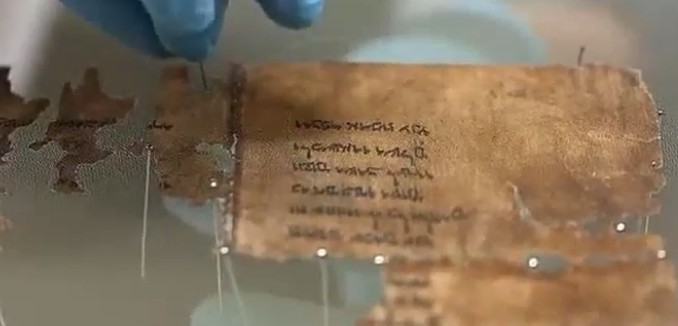Researchers at University of Haifa have pieced together a calendar that is believed to be the next-to-last unpublished text among the Dead Sea Scrolls, The Jerusalem Post reported Sunday.
The 364-day calendar was pieced together from some 60 parchment fragments, some measuring smaller than one square centimeter.
Unlike the standard Jewish lunar calendar which varies in length from year to year, a 364-day calendar ensures that holidays also fall out on the same day of the week year after year.
Originally, the fragments were thought to belong to different scrolls, but annotations signaled to the researchers that they were all part of the of the same document.
The Dead Sea Scrolls refer to 900 scrolls discovered in the caves of Qumran on the western shore of the Dead Sea in 1940s and 1950s. They belong to a sect that lived in the area and did not accept the normative Judaism during the Second Temple period.
“The reward for their hard work is fresh insight into the unique 364-day calendar used by the members of the Judean Desert sect, including the discovery for the first time of the name given by the sect to the special days marking the transitions between the four seasons,” a statement released Sunday by the university said.
The decoding of the scroll was done by Dr. Eshbal Ratson and Prof. Jonathan Ben-Dov, researchers at the university’s Department of Bible Studies.
“An important peculiarity of the present discovery is the fact that the [Qumran] sect followed a 364-day calendar,” the university’s statement said.
“The lunar calendar, which Judaism follows to this day, requires a large number of human decisions. People must look at the stars and moon and report on their observations, and someone must be empowered to decide on the new month and the application of leap years.”
Because the 364-day calendar can be divided into groups of four (weeks per month) and seven (days per week), the calendar was regarded by the sect as “perfect.”
The scroll also told of celebrations observed by the sect, and mentioned in other scrolls but not mentioned in the Bible, called the festivals of New Wine and New Oil. According to the calendar, the sect would observe the Festival of New Wheat, fifty days after the Sabbath following Passover, at roughly the same time that the festival of Shavuot would be observed. The Festival of New Wine would be observed 50 days later and the Festival of New Oil would be observed fifty days after that.
Even though the matters discussed in the calendar were well-known, the calendar, as was common at that time, was written in code. According to the researchers at the time, leaders would “write in secret code even when discussing universally-known matters, as a reflection of their status.”
The researchers also found numerous terms that appear in the Mishnah, the first written compilation of Judaism’s Oral Law, several centuries later. “This shows once again that many of the subjects discussed by the scribes several centuries later had origins that predated the Second Temple period,” the researchers observed.
[Photo: US Sciencetech / YouTube]




